Recommended Blogs
AI-Driven Low Code Development: A Booming Technology Trend
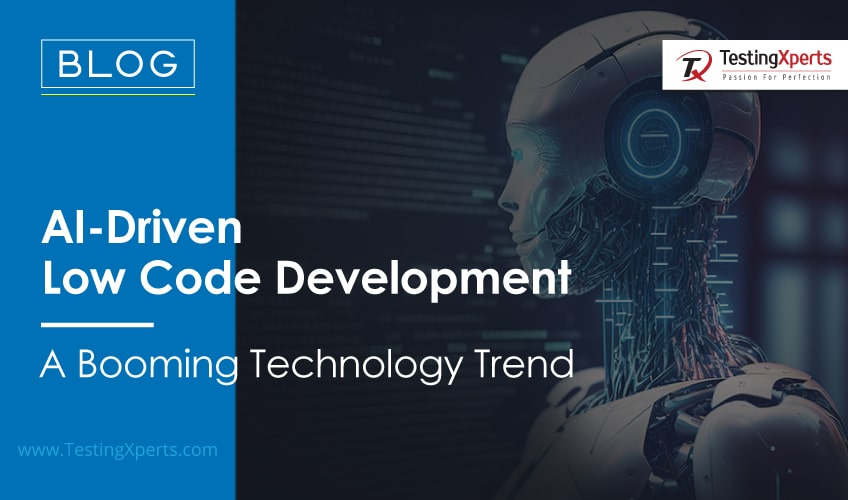
- Why Choose AI-driven low code development?
- Use cases of AI-driven low code development
- Companies that have successfully implemented AI-driven low code development:
- Examples of applications built using AI-driven low code development
- Future trends of AI-driven low code development
- Predictions on how AI will continue to impact low code development in the future
- Conclusion
- How TestingXperts can help with the testing of AI driven low code applications
AI is increasingly being used to enable intelligent automation in low code development. AI-powered automation techniques can automate repetitive tasks such as code generation, testing, and quality assurance, freeing up developers to focus on more complex tasks. In addition, AI can analyze data and provide recommendations for optimal design and architecture decisions, making development more efficient and effective.
Natural language processing can also be used to translate natural language into code, making coding accessible to non-technical users. Predictive analytics can analyze large amounts of data to predict future trends and identify potential issues, allowing developers to proactively address them before they become problems. By leveraging AI to enable intelligent automation, low code development can increase productivity, reduce development time and costs, and deliver higher-quality applications.
Why Choose AI-driven low code development?
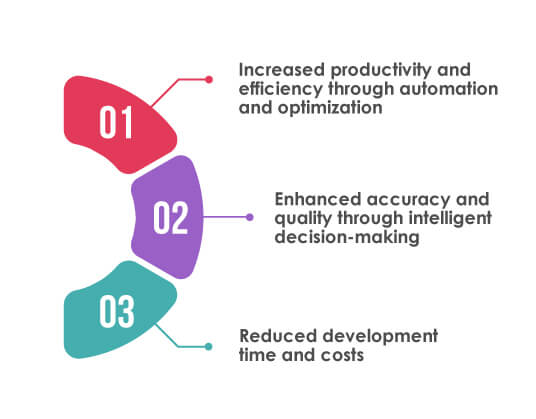
AI-driven low code development brings together two powerful technologies to help businesses develop software applications more quickly and efficiently than ever before. With low code development, non-technical users can create applications using visual interfaces and pre-built components, reducing the need for manual coding. By adding AI into the mix, these development platforms can automatically generate code and optimize application performance, further reducing the need for manual coding and testing.
The benefits of AI-driven low code development include:
Increased productivity and efficiency through automation and optimization
Automation and optimization are key strategies for businesses looking to increase productivity and efficiency. By automating repetitive or time-consuming tasks, businesses can free up their employees to focus on higher-level tasks that require creativity and problem-solving skills. This can improve productivity and job satisfaction while reducing the risk of burnout. Additionally, by optimizing workflows and processes, businesses can identify bottlenecks and inefficiencies and streamline their operations to reduce waste and increase output.
This can also lead to cost savings and improved customer satisfaction. With the rise of new technologies such as artificial intelligence and machine learning, businesses can now automate and optimize more complex tasks, such as data analysis and decision-making. By leveraging these technologies, businesses can gain insights and make decisions more quickly and accurately than ever before, further improving their productivity and efficiency. Automation and optimization are very powerful tools that can help businesses improve their operations, reduce costs, and stay competitive in today’s fast-paced business environment.
Enhanced accuracy and quality through intelligent decision-making
Intelligent decision-making can help businesses enhance accuracy and quality in their operations. By leveraging data and advanced analytics, businesses can gain insights into customer behavior, market trends, and operational performance. This can help them make more informed decisions and identify areas for improvement. Additionally, by using artificial intelligence and machine learning algorithms, businesses can automate decision-making processes, reducing the risk of human error and improving the accuracy of decisions. For example, in manufacturing, machine learning algorithms can be used to predict equipment failures before they occur, reducing downtime and improving product quality.
In healthcare, machine learning can be used to analyze medical images and assist in diagnosis, improving accuracy and reducing the risk of misdiagnosis. By making more accurate decisions, businesses can improve the quality of their products and services, reduce costs, and increase customer satisfaction. Furthermore, by continuously analyzing data and refining their decision-making processes, businesses can stay ahead of the competition and adapt to changing market conditions. Ultimately, intelligent decision-making can help businesses make better, more informed decisions, resulting in improved accuracy and quality in their operations.
Reduced development time and costs
AI low code development is a powerful approach that can help businesses reduce development time and costs. Traditional software development can be time-consuming and expensive, requiring significant resources to manually write and test code. With low code development, however, businesses can leverage pre-built components and visual interfaces to quickly and easily create applications, reducing the need for manual coding.
Additionally, by incorporating AI into the development process, these low code platforms can automatically generate code and optimize application performance, further reducing development time and costs. AI can also help identify potential bugs and errors before they occur, reducing the time and effort required for testing and debugging. By reducing development time and costs, businesses can bring products and services to market more quickly and at a lower cost, allowing them to stay ahead of the competition and respond to changing market demands.
Use cases of AI-driven low code development

AI-driven low code development has many use cases across various industries. Here are a few examples:
E-commerce:
AI-driven low code development can be used to create personalized shopping experiences for customers. By analyzing customer data, AI algorithms can generate personalized product recommendations and pricing, improving customer satisfaction and increasing sales.
Healthcare:
AI-driven low code development can be used to create applications for medical diagnosis and treatment. For example, AI/machine learning algorithms can be used to analyze medical images and assist in diagnosis, while low code development can be used to create user-friendly interfaces for healthcare professionals.
Manufacturing:
AI-driven low code development can be used to improve quality control and reduce downtime. For example, AI/machine learning algorithms can be used to predict equipment failures before they occur, while low code development can be used to create user-friendly interfaces for monitoring and maintenance.
Financial services:
AI-driven low code development can be used to create applications for fraud detection and prevention. By analyzing transaction data, AI algorithms can identify suspicious activity and alert financial institutions, reducing the risk of fraud.
Education:
AI-driven low code development can be used to create applications for personalized learning. By analyzing student data, AI algorithms can generate personalized learning paths and recommendations, improving student engagement and learning outcomes.
These are just a few examples of the many use cases for AI-driven low code development. Ultimately, this approach can be used in any industry where there is a need for efficient, user-friendly software applications that leverage the power of AI.
Companies that have successfully implemented AI-driven low code development

There are many companies that have successfully implemented AI-driven low code development to improve their operations and achieve business success. Here are a few examples:
Siemens:
Siemens, a multinational technology company, used AI-driven low code development to create an application that optimized the performance of wind turbines. The application used machine learning algorithms to predict turbine performance and maintenance needs, reducing downtime and improving overall turbine efficiency.
Uber:
Uber, a ride-hailing company, used AI-driven low code development to create an application that optimized the matching of riders and drivers. The application used machine learning algorithms to predict rider demand and driver availability, improving the efficiency and accuracy of the matching process.
Johnson & Johnson:
Johnson & Johnson, a healthcare company, used AI-driven low code development to create an application that improved patient care. The application used machine learning algorithms to analyze patient data and identify potential risks and opportunities for intervention, improving the quality and efficiency of patient care.
Examples of applications built using AI-driven low code development
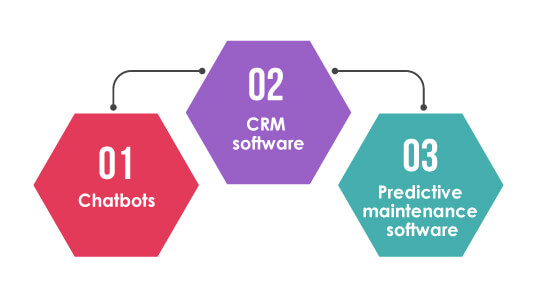
There are many applications that have been built using AI-driven low code development. Here are a few examples:
Chatbots:
Chatbots are another popular application built using AI-driven low code development. These applications use natural language processing (NLP) and machine learning algorithms to understand and respond to customer inquiries, improving customer service and reducing the need for human intervention.
CRM software:
Customer relationship management (CRM) software is a popular application that has been built using AI-driven low code development. These applications use machine learning algorithms to analyze customer data and provide personalized recommendations for sales and marketing teams.
Predictive maintenance software:
Predictive maintenance software is another application built using AI-driven low code development. These applications use machine learning algorithms to analyze equipment data and predict potential equipment failures, allowing for proactive maintenance and reducing downtime.
Future trends of AI-driven low code development
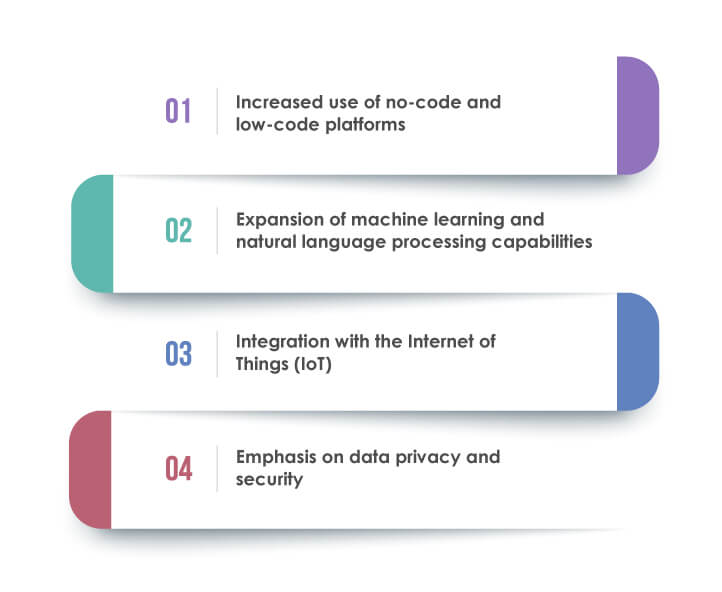
AI-driven low code development is a rapidly evolving field, and there are several trends that are likely to shape its future. Here are a few:
Increased use of no-code and low-code platforms:
As the demand for software continues to grow, we can expect to see an increased use of no-code and low-code platforms, which allow users to build software without needing to know how to code. This trend will enable more people to create applications using AI-driven low code development, supported by AI testing services to ensure functionality and performance—democratizing access to technology and empowering innovation.
Expansion of machine learning and natural language processing capabilities:
As machine learning and natural language processing continue to improve, we can expect to see more applications built using AI-driven low code development that leverage these capabilities. This will enable more sophisticated applications that can analyze complex data sets and interact with users more naturally.
Integration with the Internet of Things (IoT):
As the number of connected devices continues to grow, we can expect to see more applications built using AI-driven low code development that are designed to work with IoT devices. These applications will be able to collect and analyze data from a variety of sensors and devices, enabling more efficient and automated systems.
Emphasis on data privacy and security:
As the importance of data privacy and security continues to grow, we can expect to see more emphasis placed on building applications using AI-driven low code development that are secure and compliant with data privacy regulations.
Predictions on how AI will continue to impact low code development in the future
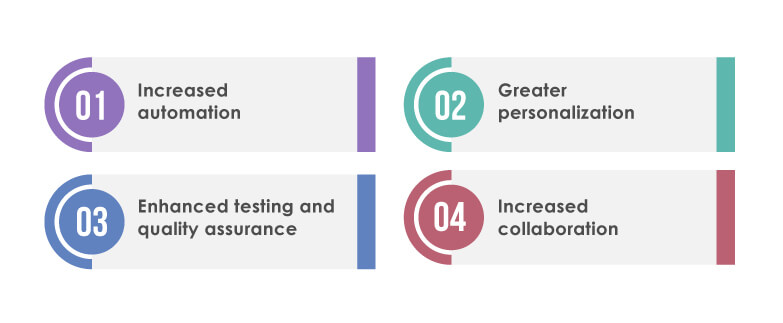
AI is likely to have a significant impact on low code development in the future. Here are a few predictions:
Increased automation:
As AI and machine learning algorithms become more sophisticated, we can expect to see increased automation of the software development process. This will enable low code developers to build applications more quickly and with fewer errors, allowing them to focus on more complex tasks.
Greater personalization:
AI will also enable low code developers to build applications that are more personalized to the needs of individual users. This could include recommendations for products and services, as well as tailored interfaces and user experiences.
Enhanced testing and quality assurance:
AI-driven testing and quality assurance tools will enable low code developers to identify bugs and issues in applications more quickly and accurately. This will help to reduce the time and resources required for testing and improve the overall quality of the software.
Increased collaboration:
As AI becomes more integrated into the software development process, we can expect to see increased collaboration between developers, data scientists, and other stakeholders. This will enable teams to work more efficiently and effectively, and to build applications that leverage the full power of AI and machine learning.
Conclusion
AI is likely to continue to play an increasingly important role in low code development in the coming years, enabling developers to build more sophisticated, personalized, and efficient applications with fewer resources and less time.
While still ensuring that they meet the needs of users and comply with data privacy and security regulations. As AI continues to evolve and become more sophisticated, we can expect to see even greater innovation in low-code development, with new applications and use cases emerging to meet the changing needs of businesses and consumers. Ultimately, AI-driven low code development will enable intelligent automation and transform the way we build and use software applications.
How TestingXperts can help with the testing of AI driven low code applications
TestingXperts is one of the world’s top 5 software testing and QA services company with extensive experience in testing AI-driven low code applications. TestingXperts offers a wide range of testing services, including automation testing, functional testing, performance testing, security testing, and more. For AI-driven low code applications, TestingXperts can help to automate the testing process, using tools and frameworks and beyond that its own accelerators like Tx-Automate, Capture and Tx-Hyperautomate to better the experience. TestingXperts also offers testing services for machine learning models used in AI-driven low code applications, including data preparation and model validation. With its deep expertise in software testing and its commitment to quality, TestingXperts can help to ensure that AI-driven low code applications are thoroughly tested, reliable, and deliver the expected value to end-users.
Discover more
